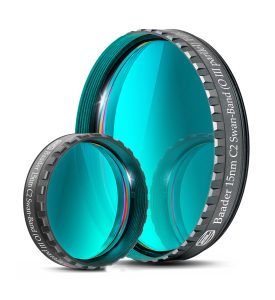The Baader C2 SWAN Band comet filter is a filter for comet hunters that provides a contrast gain for the two brightest C2 emission lines at 511 and 514nm (called “Swan band”) in the gas tail or the gas envelope of comets.
 These two emission lines, named Swan bands after their discoverer, dominate the spectrum of a comet’s gas tail in the visible range. The filter allows only the light from the two carbon bands to pass through and, among other things, blocks ubiquitous stray light, similar to nebula filters for deep-sky use. Structures in the gas tail thus become easier to observe, even under challenging observing conditions.
These two emission lines, named Swan bands after their discoverer, dominate the spectrum of a comet’s gas tail in the visible range. The filter allows only the light from the two carbon bands to pass through and, among other things, blocks ubiquitous stray light, similar to nebula filters for deep-sky use. Structures in the gas tail thus become easier to observe, even under challenging observing conditions.
The Baader C2 SWAN Band comet filter completely blocks the OIII line at 501nm and below, which some other Swan-Band filters can allow to pass. This provides even higher contrast, and comets with gas tails can be more easily distinguished from those dominated by a dust tail, where a typical SWAN filter offers only a small contrast enhancement.
As the Baader team notes, “The SwanBand filter is indeed a very special filter with central wavelength at 512 nm and ≤15nm half-width and, for the first time, without any O III transmission. It is therefore suitable for a variety of unusual applications, some of which require further investigation, whether as an “O III parallel filter” to better remove stars from the image, or as a solar filter in a previously inaccessible section of the spectrum.”

As the Baader team also notes, “Just in time for the introduction of the new C2 Swan-Band filter, a bright comet, Comet C/2022 E3 (ZTF), offered itself as a test object. Our customer, Andreas Bringmann, was one of our first testers. The accompanying image was taken by Andreas from the big city and with an almost full Moon. One can clearly see the amount of “doubly ionized carbon” (the carbon excited to glow only emits in the wavelengths 511 nm and 514 nm) that was emitted by the comet. The filter shows the complete extent of the ion cloud around a comet.
The Baader C2 SWAN Band comet filter filter specifications include:
Type of filter: Bandpass
Transmission range. ≤ 505 – 520 nm
Filter thickness (without cell): 2 mm
HBW (Half-bandwidth): HBW ≤ 15nm
CWL (Central Wavelength):513 nm (for the C2 lines at 511 and 514nm)
AR-Coating: Dielectrically coated, planeoptically polished
Filter size: 1.25 inch
Filter Usage: Gas evolution of comets, O-III-parallel imaging, contrast enhancement
You can learn more about the Baader C2 SWAN Band comet filter here.

 And to make it easier for you to get the most extensive news, articles and reviews that are only available in the magazine pages of Astronomy Technology Today, we are offering a 1-year magazine subscription for only $6! Or, for an even better deal, we are offering 2 years for only $9. Click here to get these deals which only will be available for a very limited time. You can also check out a free sample issue here.
And to make it easier for you to get the most extensive news, articles and reviews that are only available in the magazine pages of Astronomy Technology Today, we are offering a 1-year magazine subscription for only $6! Or, for an even better deal, we are offering 2 years for only $9. Click here to get these deals which only will be available for a very limited time. You can also check out a free sample issue here.
The Sun is more active than it’s been in years and if that’s not enough, we have the Annular Solar Eclipse on October 14, 2023 and the Total Solar Eclipse on April 8, 2024! If you’d like to learn more about the technology behind solar observing, solar imaging and more, you can check out our new monthly magazine – Solar Astronomy Today. It’s free to read, no subscription needed and available here. And if you are preparing for the upcoming eclipses and want to know your equipment options from solar glasses to the most out of this world solar viewing and imaging options, check out our free publication – The Definitive Guide to Viewing and Imaging the Sun – simply click here and enjoy reading!

